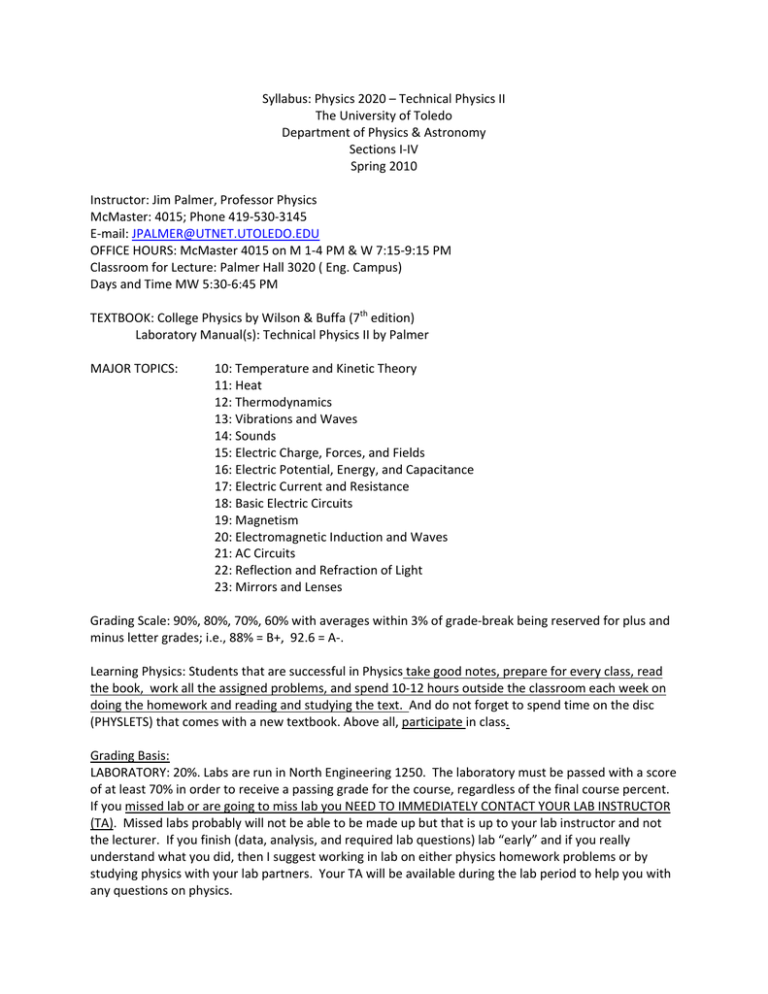Technical Physics II - The University of Toledo
advertisement

Syllabus: Physics 2020 – Technical Physics II The University of Toledo Department of Physics & Astronomy Sections I‐IV Spring 2010 Instructor: Jim Palmer, Professor Physics McMaster: 4015; Phone 419‐530‐3145 E‐mail: JPALMER@UTNET.UTOLEDO.EDU OFFICE HOURS: McMaster 4015 on M 1‐4 PM & W 7:15‐9:15 PM Classroom for Lecture: Palmer Hall 3020 ( Eng. Campus) Days and Time MW 5:30‐6:45 PM TEXTBOOK: College Physics by Wilson & Buffa (7th edition) Laboratory Manual(s): Technical Physics II by Palmer MAJOR TOPICS: 10: Temperature and Kinetic Theory 11: Heat 12: Thermodynamics 13: Vibrations and Waves 14: Sounds 15: Electric Charge, Forces, and Fields 16: Electric Potential, Energy, and Capacitance 17: Electric Current and Resistance 18: Basic Electric Circuits 19: Magnetism 20: Electromagnetic Induction and Waves 21: AC Circuits 22: Reflection and Refraction of Light 23: Mirrors and Lenses Grading Scale: 90%, 80%, 70%, 60% with averages within 3% of grade‐break being reserved for plus and minus letter grades; i.e., 88% = B+, 92.6 = A‐. Learning Physics: Students that are successful in Physics take good notes, prepare for every class, read the book, work all the assigned problems, and spend 10‐12 hours outside the classroom each week on doing the homework and reading and studying the text. And do not forget to spend time on the disc (PHYSLETS) that comes with a new textbook. Above all, participate in class. Grading Basis: LABORATORY: 20%. Labs are run in North Engineering 1250. The laboratory must be passed with a score of at least 70% in order to receive a passing grade for the course, regardless of the final course percent. If you missed lab or are going to miss lab you NEED TO IMMEDIATELY CONTACT YOUR LAB INSTRUCTOR (TA). Missed labs probably will not be able to be made up but that is up to your lab instructor and not the lecturer. If you finish (data, analysis, and required lab questions) lab “early” and if you really understand what you did, then I suggest working in lab on either physics homework problems or by studying physics with your lab partners. Your TA will be available during the lab period to help you with any questions on physics. Lecture: 80% Exam #1 (15%) Temperature, Ideal gas, Kinetic Theory, Heat, and Thermodynamics Quiz #1 (5%) Vibrations, Waves, & Sound Exam #2 (15%) Electricity & Magnetism Exam #3 (15%) Optics OTHER: (15%) Unannounced quizzes (maximum of 5, with highest 3 used in final grade computation), special assignments, and collected homework. No make‐ups on unannounced quizzes. Exam #4 (15%) FINAL EXAM: comprehensive (Time limit: 100 min.) FINAL EXAM: DATE: Monday May 2, 2011 5‐7pm Missed exams cannot be made up except in extenuating circumstances as determined by the instructor. Once the exam/RESULT is passed back the missed exam cannot be made up for a grade. An excused missed exam not made up (in time) will result in the final exam counting an additional percent equal to the percent of the exam that is missed. No more than one missed excused exam is permitted without receiving a zero for the exam. There is no grade for attendance but attendance is highly recommended. Students are responsible for withdrawing. Last day to withdraw historically has been at the end of the 10th week but that may have been changed) Quiz #1 and all 4 exams will be ‘announced” during the lecture period before the quiz or exam and also one week before the exam. It should be obvious that exams follow presentation of the material as listed. Not everything you need to know for exams is in lecture; likewise, not everything you need to know for exams is in the text. But between the text, lecture, and laboratory you will be exposed to the principles of all testable material. All testing is timed. You need to know and understand the material well enough to be able to finish in the time allotted. You should practice problem setups and problem types so you can finish in time. Exams will be allowed 55 minutes for completion. The syllabus may be changed to fit the circumstances; for example, snow emergency, instructor illness, change in University policy, etc. It may also be changed to fit the pace of the class; that is, subject matter maybe partitioned differently from that listed so that exams occur more evenly spaced, for example, every 3‐4 weeks. Or office hours may also be changed to fit changing circumstances. Laboratory Topics Laboratory Orientation Experiment 1: Linear Thermal Expansion of Metals Experiment 2: Specific Heat Capacity Experiment 3: Latent Heat of Fusion Experiment 4: Simple Harmonic Motion Experiment 5: Velocity of Sound in Air Experiment 6: Basic Electric Circuits Experiment 7: Resistance and Ohm's Law Experiment 8: Series and Parallel Circuits Experiment 9: Wheatstone Bridge Experiment 10: Spectroscopic Analysis of Light Experiment 11: Index of Refraction Experiment 12: Lenses
